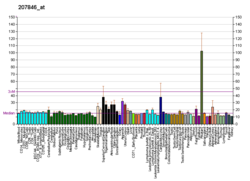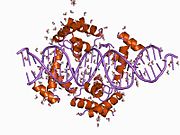Pituitary-specific positive transcription factor 1
POU class 1 homeobox 1, also known as pituitary-specific positive transcription factor 1 (PIT1), POU domain, class 1, transcription factor 1 (POU1F1) and growth hormone factor 1 (GHF1), is a transcription factor for growth hormone encoded by the gene POU1F1.[5][6]
Function
[edit]PIT1 is part of the POU family of transcription factors.[7] It is expressed by somatotrophic cells,[8] as well as thyrotrophs[9] and lactotrophs[10] of the anterior pituitary gland. It contains a C-terminal domain for transactivation.[9] Another domain is DNA binding—its C-terminal portion is homologous to the homeodomain consensus,[8] common to many genes involved in development, while the other portion is POU specific, affords PIT1 specificity in its transcriptional activation of the prolactin and growth hormone genes and is involved in protein-protein interactions.[9] Activity on thyroid stimulating hormone-beta expression is also known for PIT1.[9]
Interactions
[edit]Pituitary-specific positive transcription factor 1 has been shown to interact with GATA2[11] and PITX1.[12]
References
[edit]- ^ a b c GRCh38: Ensembl release 89: ENSG00000064835 – Ensembl, May 2017
- ^ a b c GRCm38: Ensembl release 89: ENSMUSG00000004842 – Ensembl, May 2017
- ^ "Human PubMed Reference:". National Center for Biotechnology Information, U.S. National Library of Medicine.
- ^ "Mouse PubMed Reference:". National Center for Biotechnology Information, U.S. National Library of Medicine.
- ^ "Entrez Gene: POU1F1 POU class 1 homeobox 1 [ Homo sapiens (human) ]". National Library of Medicine, National Center for Biotechnology Information. 23 November 2023. Retrieved 2 January 2024.
- ^ "Symbol report for POU1F1". HGNC. HUGO Gene Nomenclature Committee. 2023. Retrieved 2 January 2024.
- ^ O'Neill, Marla J.F. (22 September 2021) [Originally authored by Victor A. McKusick on 13 January 1989]. "POU DOMAIN, CLASS 1, TRANSCRIPTION FACTOR 1; POU1F1". Online Mendelian Inheritance in Man. Retrieved 3 January 2024.
- ^ a b Bodner M, Castrillo JL, Theill LE, Deerinck T, Ellisman M, Karin M (1988). "The pituitary-specific transcription factor GHF-1 is a homeobox-containing protein". Cell. 55 (3): 505–518. doi:10.1016/0092-8674(88)90037-2. PMID 2902927. S2CID 26376487.
- ^ a b c d Vallette-Kasic S, Pellegrini-Bouiller I, Sampieri F, Gunz G, Diaz A, Radovic S, Enjalbert A, Brue T (2001). "Combined Pituitary Hormone Deficiency due to the F135C Human Pit-1 (Pituitary-Specific Factor 1) Gene Mutation: Functional and Structural Correlates". Molecular Endocrinology. 15 (3): 411–420. doi:10.1210/mend.15.3.0601. PMID 11222742.
- ^ Cohen LE, Wondisford FE, Radovick S (1996). "Role of Pit-1 in the gene expression of growth hormone, prolactin, and thyrotropin". Endocrinology and Metabolism Clinics of North America. 25 (3): 523–540. doi:10.1016/s0889-8529(05)70339-x. PMID 8879985.
- ^ Dasen JS, O'Connell SM, Flynn SE, Treier M, Gleiberman AS, Szeto DP, Hooshmand F, Aggarwal AK, Rosenfeld MG (May 1999). "Reciprocal interactions of Pit1 and GATA2 mediate signaling gradient-induced determination of pituitary cell types". Cell. 97 (5): 587–98. doi:10.1016/S0092-8674(00)80770-9. PMID 10367888. S2CID 15737684.
- ^ Szeto DP, Ryan AK, O'Connell SM, Rosenfeld MG (July 1996). "P-OTX: a PIT-1-interacting homeodomain factor expressed during anterior pituitary gland development". Proc. Natl. Acad. Sci. U.S.A. 93 (15): 7706–10. Bibcode:1996PNAS...93.7706S. doi:10.1073/pnas.93.15.7706. PMC 38811. PMID 8755540.
Further reading
[edit]- Parks JS, Brown MR (1999). "Transcription factors regulating pituitary development". Growth Horm. IGF Res. 9 Suppl B: 2–8, discussion 8–11. doi:10.1016/S1096-6374(99)80074-4. PMID 10549299.
- Rodriguez R, Andersen B (2003). "Cellular determination in the anterior pituitary gland: PIT-1 and PROP-1 mutations as causes of human combined pituitary hormone deficiency". Minerva Endocrinol. 28 (2): 123–33. PMID 12717343.
- Quentien MH, Barlier A, Franc JL, Pellegrini I, Brue T, Enjalbert A (2006). "Pituitary transcription factors: from congenital deficiencies to gene therapy". J. Neuroendocrinol. 18 (9): 633–42. doi:10.1111/j.1365-2826.2006.01461.x. PMID 16879162. S2CID 21835164.
- Cattini PA, Yang X, Jin Y, Detillieux KA (2006). "Regulation of the human growth hormone gene family: possible role for Pit-1 in early stages of pituitary-specific expression and repression". Neuroendocrinology. 83 (3–4): 145–53. doi:10.1159/000095522. PMID 17047377. S2CID 34757447.
- Li X, Giachelli CM (2007). "Sodium-dependent phosphate cotransporters and vascular calcification". Curr. Opin. Nephrol. Hypertens. 16 (4): 325–8. doi:10.1097/MNH.0b013e3281c55ef1. PMID 17565274. S2CID 25963053.
- Tatsumi K, Miyai K, Notomi T, Kaibe K, Amino N, Mizuno Y, Kohno H (1993). "Cretinism with combined hormone deficiency caused by a mutation in the PIT1 gene". Nat. Genet. 1 (1): 56–8. doi:10.1038/ng0492-56. PMID 1302000. S2CID 36138691.
- Tatsumi K, Notomi T, Amino N, Miyai K (1992). "Nucleotide sequence of the complementary DNA for human Pit-1/GHF-1". Biochim. Biophys. Acta. 1129 (2): 231–4. doi:10.1016/0167-4781(92)90494-k. PMID 1370379.
- Ohta K, Nobukuni Y, Mitsubuchi H, Fujimoto S, Matsuo N, Inagaki H, Endo F, Matsuda I (1993). "Mutations in the Pit-1 gene in children with combined pituitary hormone deficiency". Biochem. Biophys. Res. Commun. 189 (2): 851–5. doi:10.1016/0006-291X(92)92281-2. PMID 1472057.
- Ohta K, Nobukuni Y, Mitsubuchi H, Ohta T, Tohma T, Jinno Y, Endo F, Matsuda I (1993). "Characterization of the gene encoding human pituitary-specific transcription factor, Pit-1". Gene. 122 (2): 387–8. doi:10.1016/0378-1119(92)90234-G. PMID 1487156.
- Radovick S, Nations M, Du Y, Berg LA, Weintraub BD, Wondisford FE (1992). "A mutation in the POU-homeodomain of Pit-1 responsible for combined pituitary hormone deficiency". Science. 257 (5073): 1115–8. Bibcode:1992Sci...257.1115R. doi:10.1126/science.257.5073.1115. PMID 1509262. S2CID 33620091.
- Pfäffle RW, DiMattia GE, Parks JS, Brown MR, Wit JM, Jansen M, Van der Nat H, Van den Brande JL, Rosenfeld MG, Ingraham HA (1992). "Mutation of the POU-specific domain of Pit-1 and hypopituitarism without pituitary hypoplasia". Science. 257 (5073): 1118–21. Bibcode:1992Sci...257.1118P. doi:10.1126/science.257.5073.1118. PMID 1509263. S2CID 32400112.
- Lew AM, Elsholtz HP (1991). "Cloning of the human cDNA for transcription factor Pit-1". Nucleic Acids Res. 19 (22): 6329. doi:10.1093/nar/19.22.6329. PMC 329149. PMID 1956794.
- He X, Treacy MN, Simmons DM, Ingraham HA, Swanson LW, Rosenfeld MG (1989). "Expression of a large family of POU-domain regulatory genes in mammalian brain development". Nature. 340 (6228): 35–41. Bibcode:1989Natur.340...35H. doi:10.1038/340035a0. PMID 2739723. S2CID 4275887.
- Herr W, Sturm RA, Clerc RG, Corcoran LM, Baltimore D, Sharp PA, Ingraham HA, Rosenfeld MG, Finney M, Ruvkun G (1989). "The POU domain: a large conserved region in the mammalian pit-1, oct-1, oct-2, and Caenorhabditis elegans unc-86 gene products". Genes Dev. 2 (12A): 1513–6. doi:10.1101/gad.2.12a.1513. PMID 3215510.
- de Zegher F, Pernasetti F, Vanhole C, Devlieger H, Van den Berghe G, Martial JA (1995). "The prenatal role of thyroid hormone evidenced by fetomaternal Pit-1 deficiency". J. Clin. Endocrinol. Metab. 80 (11): 3127–30. doi:10.1210/jcem.80.11.7593413. PMID 7593413.
- Bamberger AM, Bamberger CM, Pu LP, Puy LA, Loh YP, Asa SL (1995). "Expression of pit-1 messenger ribonucleic acid and protein in the human placenta". J. Clin. Endocrinol. Metab. 80 (7): 2021–6. doi:10.1210/jcem.80.7.7608249. PMID 7608249.
- Irie Y, Tatsumi K, Ogawa M, Kamijo T, Preeyasombat C, Suprasongsin C, Amino N (1995). "A novel E250X mutation of the PIT1 gene in a patient with combined pituitary hormone deficiency". Endocr. J. 42 (3): 351–4. doi:10.1507/endocrj.42.351. PMID 7670563.
- Delhase M, Vila V, Hooghe-Peters EL, Castrillo JL (1995). "A novel pituitary transcription factor is produced by alternative splicing of the human GHF-1/PIT-1 gene". Gene. 155 (2): 273–5. doi:10.1016/0378-1119(94)00757-J. PMID 7721104.
- Okamoto N, Wada Y, Ida S, Koga R, Ozono K, Chiyo H, Hayashi A, Tatsumi K (1995). "Monoallelic expression of normal mRNA in the PIT1 mutation heterozygotes with normal phenotype and biallelic expression in the abnormal phenotype". Hum. Mol. Genet. 3 (9): 1565–8. doi:10.1093/hmg/3.9.1565. PMID 7833912.
External links
[edit]- PIT1+protein,+human at the U.S. National Library of Medicine Medical Subject Headings (MeSH)
- Transcription+Factor+Pit-1 at the U.S. National Library of Medicine Medical Subject Headings (MeSH)
| |||||||||||||||||||||||||||||||
| |||||||||||||||||||||||||||||||
| |||||||||||||||||||||||||||||||
| |||||||||||||||||||||||||||||||
| |||||||||||||||||||||||||||||||
Text is available under the CC BY-SA 4.0 license; additional terms may apply.
Images, videos and audio are available under their respective licenses.







